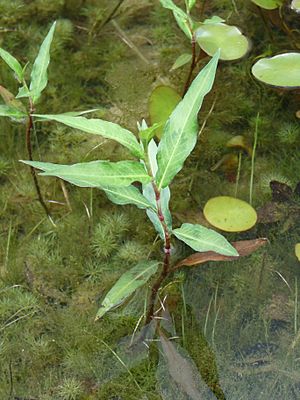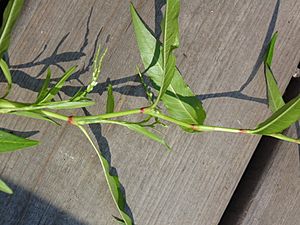Water pepper facts for kids
Quick facts for kids Water pepper |
|
|---|---|
 |
|
| Scientific classification | |
| Genus: |
Persicaria
|
| Species: |
hydropiper
|
| Synonyms | |
|
Other Names
Polygonum hydropiper L. 1753
Persicaria hydropiper (L.) Opiz 1852 Persicaria hydropiper (L.) Spach 1841 Persicaria acris Gilib. Persicaria glandulosa Nakai & Ohki Persicaria urens Garsault Persicaria vernalis Nakai Peutalis hydropiper Raf. Polygonum glandulosum Poir. Polygonum gracile Salisb. Polygonum hecasanthum Schur Polygonum hidropiper Neck. Polygonum oleraceum Schur Polygonum schinzii J. Schust. |
|
Water pepper (also known as Persicaria hydropiper, marshpepper knotweed, or tade) is a plant from the Polygonaceae family. You can find it in many parts of the world, including Australia, New Zealand, Asia, Europe, and North America. This plant loves wet places and shallow water. Some types of water pepper are grown on farms and eaten in East Asia because of their spicy taste.
Contents
What Water Pepper Looks Like
Water pepper is a plant that grows every year. Its stem stands straight up, reaching about 20 to 70 centimeters (8 to 28 inches) tall. Its leaves grow one after another along the stem and have almost no stalks. The leaves are shaped like narrow eggs and have smooth edges with very short hairs. They get narrower towards the end, which is a bit blunt.
At the base of each leaf, there are special parts called stipules. These are joined together to form a loose sheath that wraps around the stem. The top of this sheath has a fringe. The plant's flowers grow in a drooping spike. Each tiny flower has four or five parts that are joined near their green base and are white or pink at the edges. The plant also has six stamens (male parts), three carpels (female parts) joined together, and three styles. When the fruit grows, it's a dark brown, flat, oval-shaped nut.
Why Water Pepper Tastes Spicy
Water pepper contains special natural chemicals that give it its unique taste. Two of these chemicals are called polygodial and warburganal. These are what make the plant taste spicy or pungent. The plant also has a chemical called rutin, which can make it taste a bit bitter.
Water pepper also has a small amount of essential oil. This oil is made up of different compounds like alpha-pinene and beta-caryophyllene. The exact mix of these chemicals can be different depending on the specific plant. Wild water pepper plants can produce oils that might make your skin feel itchy or irritated if you touch them.
How People Use Water Pepper
Water pepper is eaten in Japan, where it is called tade (蓼). A specific type, known as yanagi tade (柳蓼), is grown for food. People use the leaves as a vegetable. However, they only eat the cultivated type, not the wild one, because the wild plant is much spicier.
You can often buy young water pepper plants in markets. The young red sprouts are called beni-tade (紅蓼). These are used to decorate dishes like sashimi, tempura, and sushi. Water pepper is a popular ingredient for cooking in the summer. Sometimes, the seeds are even added to wasabi for extra flavor.
A special sauce called tade-zu (蓼酢) is made from water pepper. To make it, finely chopped water pepper leaves are soaked in vinegar with a little bit of steamed rice. Sometimes, juice from a kabosu fruit is added. In Japanese cuisine, this sauce is traditionally served with grilled freshwater fish, but not with fish from the ocean.
In China, water pepper is known as la liao (辣蓼). It is used in traditional Chinese medicine for various purposes.
Long ago in Europe, during times of war, people sometimes grew and ate water pepper. They used it as a replacement for regular pepper when it was hard to find.
The plant has many acids, including formic acid. This makes it taste bad to most farm animals, so they usually don't eat it. Even though animals don't eat wild water pepper, some insects do! This led to a Japanese saying: "Tade kuu mushi mo sukizuki" (蓼食う虫も好き好き). This means "Some insects eat water pepper and like it," which is like saying, "There's no accounting for taste" or "Everyone has different preferences."
Gallery
See also
 In Spanish: Pimienta del agua para niños
In Spanish: Pimienta del agua para niños









